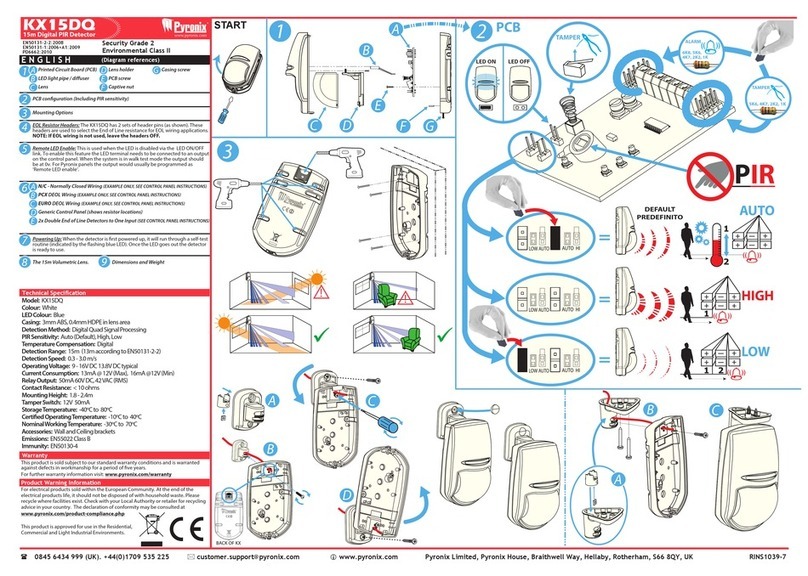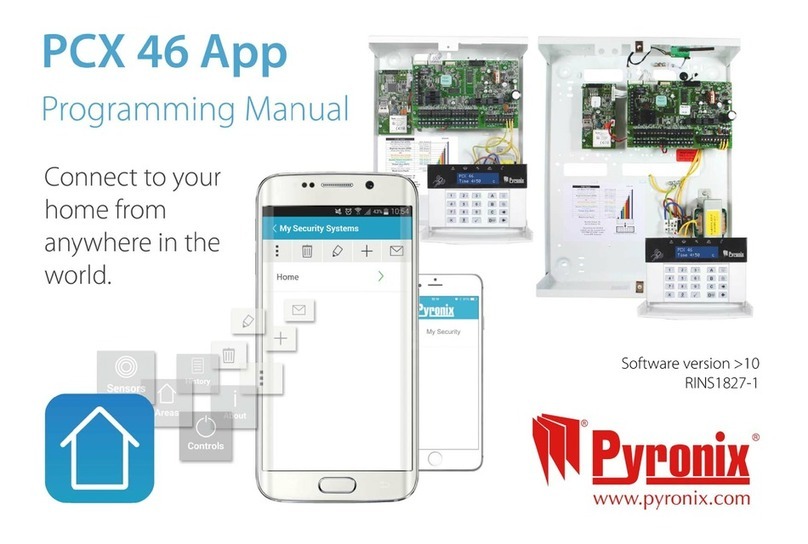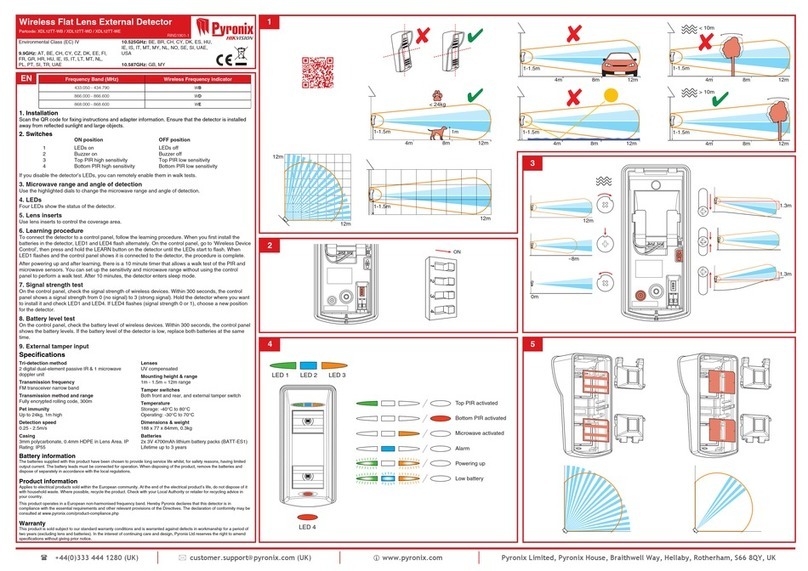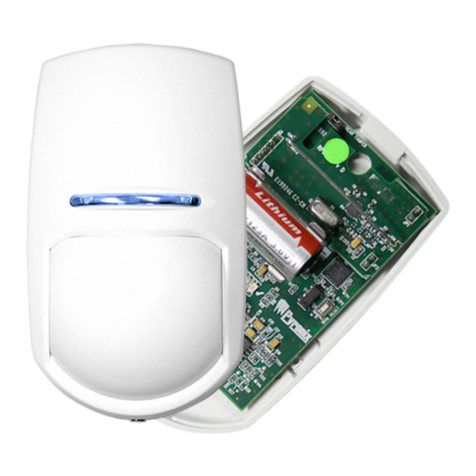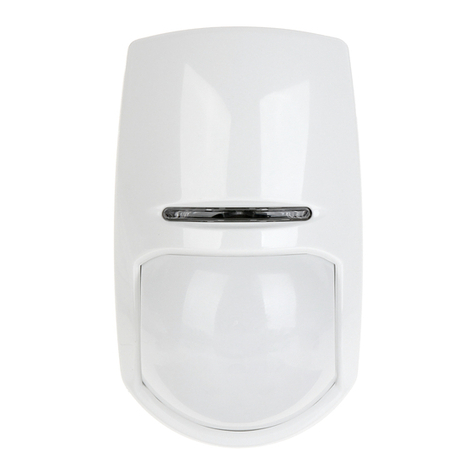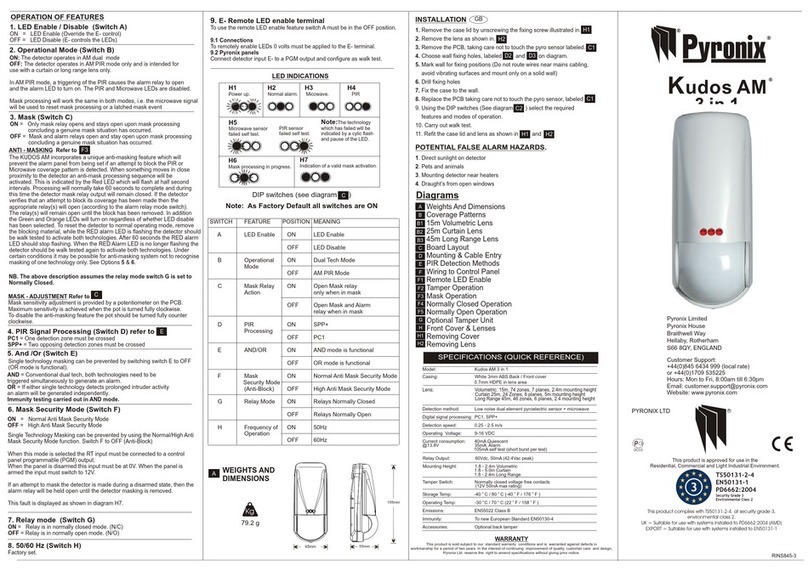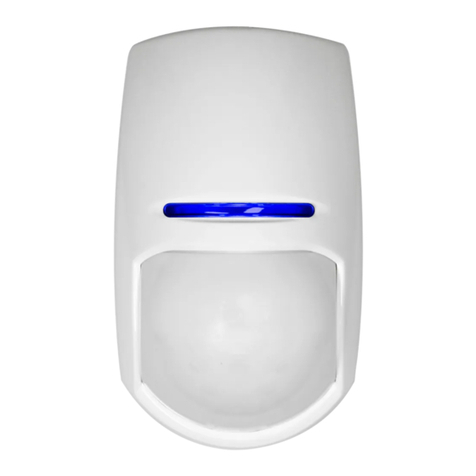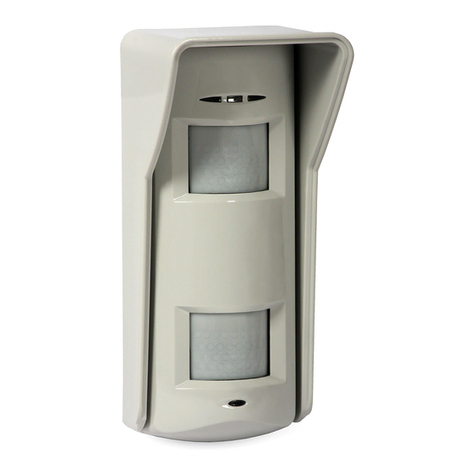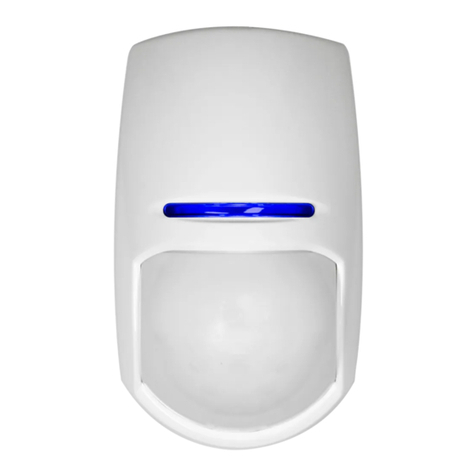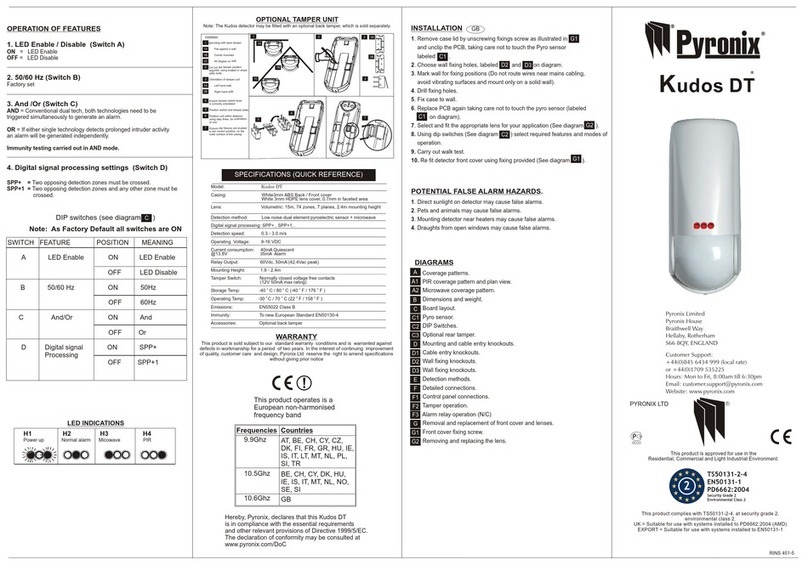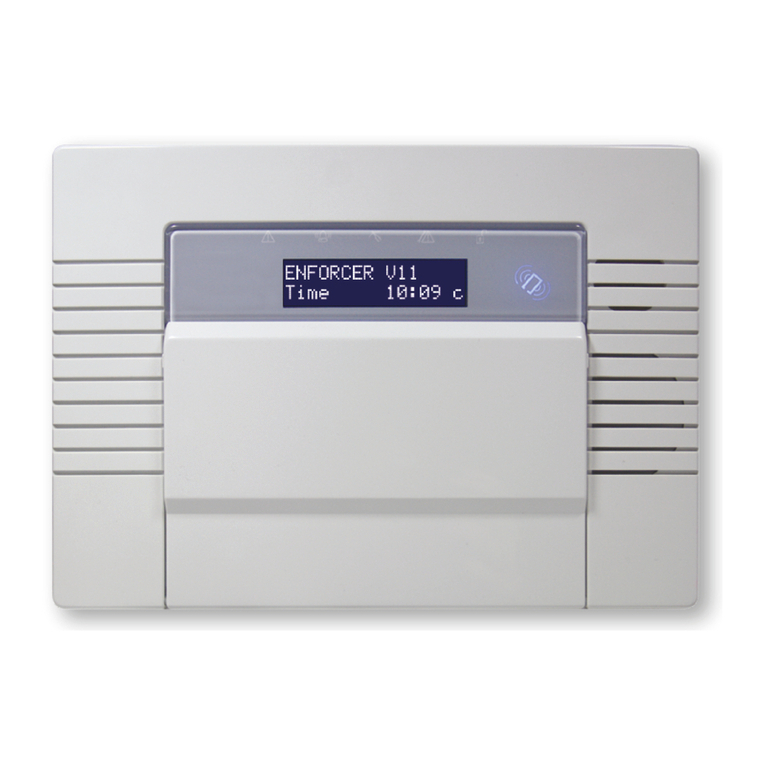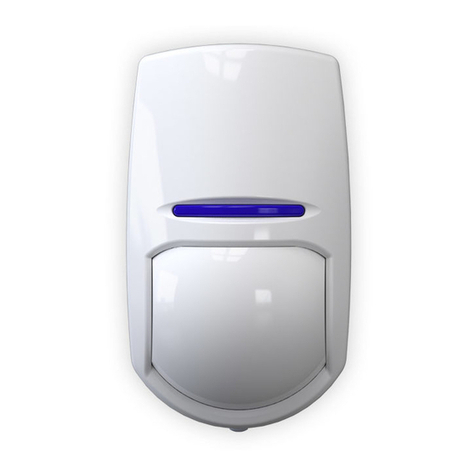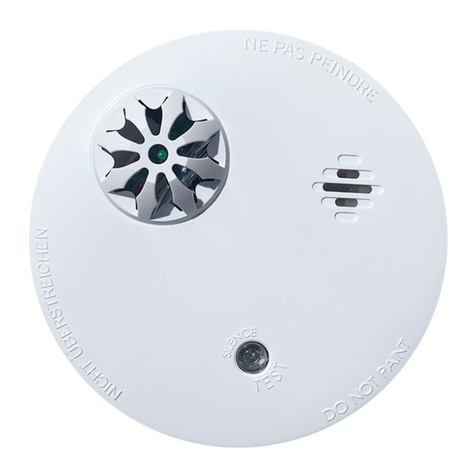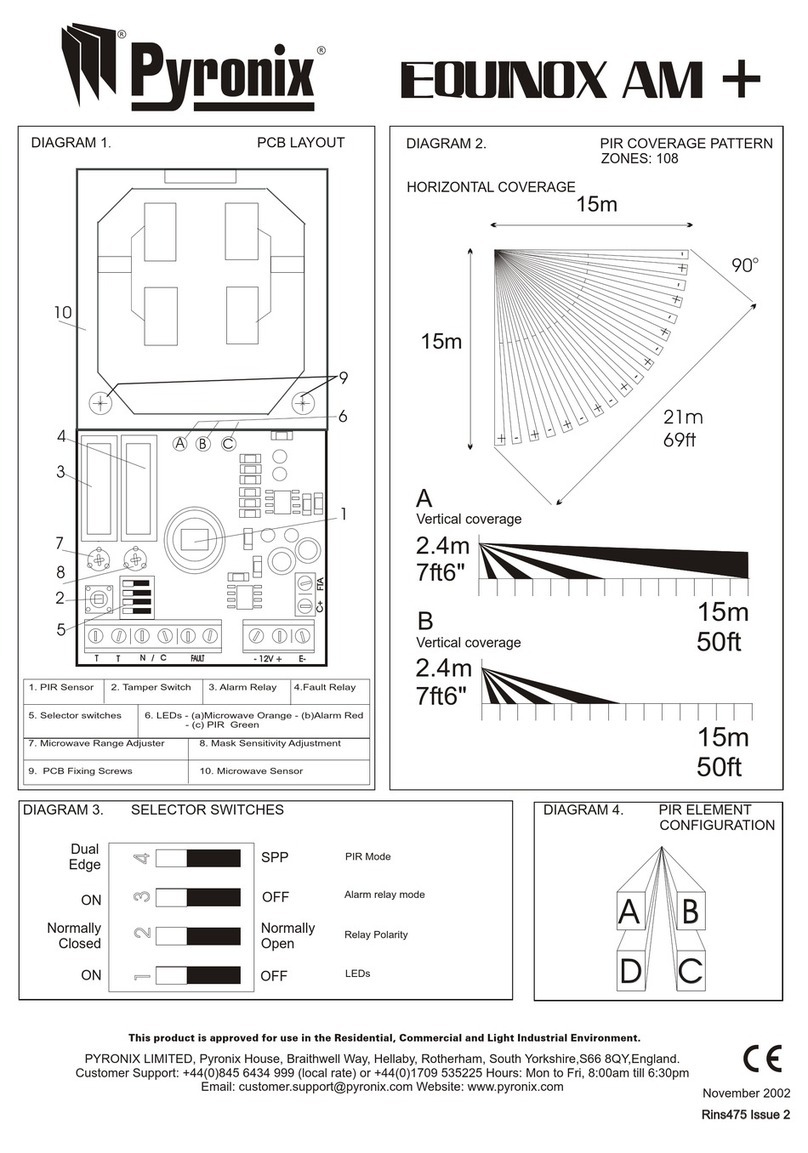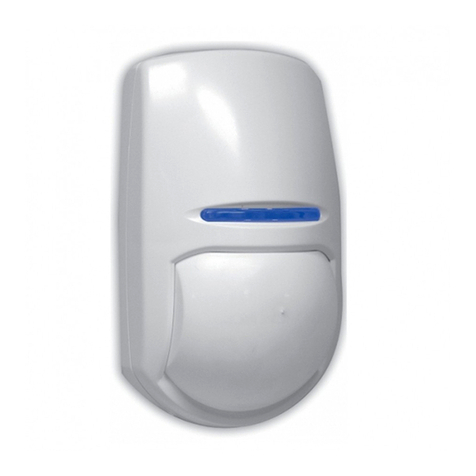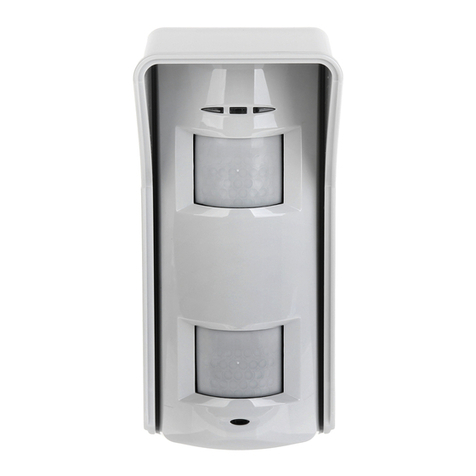
1. Smontaggio del KX. a) Circuito Stampato. b) Illuminatore della Lente. c) Lente. d) Ferma Lente. e) Vite per PCB.
f) Dado. g) Vite del Coperchio.
2. Il Circuito Stampato. a) Morsettiere b) Mains Frequency c) Sensibilità d) AND/OR mode e) Abilita/Disabilita
LED: ON = LED Abilitato / OFF = LED Disabilitato f) Sensibilità del PIR f ) Link per la Resistenza di Allarme, Tamper,
g) piro sensor h) Nota sul Potenziometro della Microonda:
3. Ingresso Cavo + Montaggio. a) Fori per le Viti di Fissaggio. b) Foro Entrata Cavo. c) Vite di Fissaggio del
Coperchio
4. Installazione della Staa a)Staa da Sotto, b)Staa da Parete
5. Guida per l’Installazione, Come evitare Falsi Allarmi 1. Non esporre il rivelatore alla luce diretta del sole,
2. Non lasciare vagare liberamente, animali domestici o altri animali, davanti al rivelatore a quando il sistema
è inserito. 3.Non installare il rivelatore nelle vicinanze dei sorgenti di calore o dei radiatori. 4. Non installare il
rivelatore vicino a canalizzazione dell’aria e condizionatori della in quanto potrebbero causare falsi allarmi 5.
Installare il rivelatore su una supercie stabile. 6. Passare il cavo di allarme lontano dall’impianto elettrico.
6. a) Sensibilità del PIR alto (difetto)
7. MODALITA’ AND/OR AND: Doppia Tecnologia Convenzionale(Entrambe le tecnologie devono essere attivate
per potere generare un allarme, OR: Se una singola tecnologia rileva una attività di prolungata verrà generato un
allarme lo stesso
8. Nota sul Potenziometro della Microonda: Girando completamente il potenziometro nel senso anti-orario si
reduce la microonda. La portata minima è 0m, la massima 10m.
9. Link per la Resistenza. Il sensore KX è munito di 2 set di pin nella parte superiore del circuito stampato. Questi
pin servono per la scelta della resistenza di ne linea da inserire nei circuiti per il collegamento alla centrale se
necessario. Dove la resistenza non è necessaria, non inserire nessun ponticello.
10. Collegamento. a) Normalmente Chiuso. b) Singolo Bilanciamento usando le resistenze a Bordo. c) Doppio
Bilanciamento usando le resistenze a Bordo. d) 2 DEOL to 1 input e) Zone Doubling
Viene mostrato un esempio di collegamento con valori di resistenza di 4k7 per l’allarme e 4k7 per il tamper.
11. Quando il rivelatore viene alimentato la prima volta, esso eseguirà l’autoapprendimento di rutine indicato dal
lampeggio del LED BLU. Quando il LED si spegne, il rivelatore è pronto all’uso.
12. Lente Volumetrica da 10m.
13. Dimensioni e Peso.
14. Speciche Tecniche
Modello: KX10DTP. Colore: Bianco. Involucro: 3mm ABS, Lente: 0.4mm HDPE. Metodo di Rilevamento: Sensore
piroelettrico doppio elemento Basso rumore & microonde doppler. Sensibilità PIR: Automatica o Conta Impulsi
1.Compensazione di Temperature: Digital. Portata: 10m. Velocità di rilevamento: 0.3 - 3.0m/s. Tensione di
Funzionamento: 9-16Vcc, 13.8Vcc tipici. Assorbimento: Min. 24mA, Max 30mA @ 12V
Uscita Relè: 50mA 60Vcc, 42Vac (RMS). Resistenza del Contatti: <10phm.
Altezza di Montaggio: 1.8m - 2.4m. Tamper: 12V 50mA. Temperatura di Stoccaggio: -40° C a 80° C (-40° F a 176° F).
Temperatura di Servizio: -30° C a 70° C (-22° F a 158° F). Accessori: Stae da Muro e da Sotto. Emissioni: EN55022
Classe B. Immunità: EN50130-4
15. Conformità e Garanzia. 16. Contatti per Informazioni.
1. Desactivar KX / Substituir Lentes. a) Placa de Circuito Impresso (PCI). b) Iluminador Lente. c) Lente. d)
Suporte Lente. e) Parafuso PCI. f ) Porca. h) Parafuso caixa.
2. A Placa Circuito Impresso. a) Terminais b) Mains Frequency. c) Sensibilidade PIR d) MODO E/OU e) LED ON/
OFF. f) Ligações Alarme/TamperResistências g) Piro Sensor. h) Potenciómetro Micro-ondas
3. Montagem+Entrada Cabos. a) Aberturas para Fixar. b) Entrada de Cabo. c) Parafuso para Encaixar Tampa
Frontal.
4. Conexões dos Suportes: a) Montagem Suporte Tecto b) Montagem Suporte Parede
5.Guia de Instalação, Evitar Falsos Alarmes
1. Evitar instalar o detector de frente para a luz solar
2. Não permitir que animais domésticos circulem livremente quando o sistema está armado.
3. Não instalar o detector próximo de fontes de calor.
4.Não instalar o detector próximo de janelas ou zonas de circulação de ar porque podem causar falsos alarmes
5. Instalar o detector numa superfície estável
6. Não instalar cabo paralelo ao cabo dos 220V.
6. Sensibilidade PIR: a) Auto
7. MODO E/OU. E: Dupla tecnologia convencional: ambas as tecnologias têm de ser activadas simultanea-
mente para gerar alarme. OU: Se uma das tecnologias detectar actividade de intrusão prolongada um alarme
será gerado
8. Potenciómetro Micro-ondas: Nota: rodar no sentido contrário aos ponteiros do relógio desliga a detecção
por micro-ondas. Mínimo Alcance (0m) Máximo alcance (10m)
9. No topo da placa de circuito impresso (PCB) do KX existem dois conjuntos de pinos. Estes dois conjuntos
permitem seleccionar as resistências m de linha (EOL) p/ esquemas de ligação com EOL. Se não for usado EOL
colocar os dois conjuntos a OFF.
10. Tipo de Ligações. a) Normalmente fechado. b) Dupla Resistência Fim de Linha usando as resistências da
PCI. c) Unico Resistência Fim de Linha usando as resistências da PCI. d) 2 DEOL to 1 input e) Zone Doubling
11. Quando o detector é alimentado, inicia uma rotina própria de testes sinalizado pelo piscar do LED azul.
Quando o LED terminar de piscar o detector está pronto a usar.
12. Dimensões e Peso.
13. Lente Volumétrica de 10m.
14. Especicações Técnicas
Modelo: KX10DTP. Cor: Branca. Caixa: 3mm ABS, 0.4mm HDPE na área da lente. Método de Detecção: Sensor
duplo elemento piroeléctrico de baixo ruído e sensor Doppler Microondas. Sensibilidade PIR: Auto ou PC1 1
Comp. Temperatura: Digital. Gama de Detecção: 10m. Velocidade de Detecção: 0.3 - 3.0m/s. Tensão de Fun-
cionamento: 9-16V DC 13.8V DC típico. Consumo de Corrente: 24mA Min. 30mA Max @ 12V
Saída de Relé: 50mA 60 VDC, 42 VAC (ecaz). Resistência Contacto: <10phms. Altura de Instalação: 1.8m - 2.4m
Contacto de Tamper: 12V 50mA. Temperatura de Armazenamento: -40 C a 80 C (-40 F a 176 F). Temperatura
Funcionamento: -30 C a 70 C (-22 F a 158 F). Acessórios: inclui suporte para Parede e Tecto. Emissões: EN55022
Classe B. Imunidade: EN50130-4
15. Conformidade e Garantia.
16. Informação de Contactos.
1. Démonter le KX / Changer la lentille. a) Platine de base. b) Eclairage lentille. c) Lentille. d) Porte lentille.
e) Vis PCB. f) Ecrou. g) Vis du boîtier.
2. Platine de base. a) Bornes b) Mains Frequency c) Sensibilité PIR: Haut ou Auto d) MODE ET/OU e) ALARM
LED f) Resistances sabotage/alarme links g) piro sensor h) Potentiomètre micro-onde
3. Entrée câble + Montage. a) Trous vis de montage. b) Passage de câble. c) Fixation couvercle
4. Raccordement support: a) Fixation support plafond. B) Fixation support mural
5. Instructions installation
Eviter fausses alarmes
1. Evitez de placer le détecteur en pleine lumière soleil.
2. Evitez de laisser promener librement les animaux quand le système est armé.
2. Ne pas installer les détecteurs près de chauages ou radiateurs.
4. Ne pas installer les détecteurs près de fenêtres ouvertes ou prises d’air, car le courant d’air peut causer des
fausses alarmes.
5. Installez le détecteur sur une surface stable.
6. Ne pas câbler parallèlement au conducteur principal.
6. PIR Sensibilité: a) Auto
7. MODE ET/OU
Double technologie conventionnel (les deux technologies doivent être déclenchées en même temps pour
générer une alarme. Si une des technologies détecte une activité intrusion prolongée, une alarme sera générée
8. Potentiomètre micro-onde : Remarque : tournez le pot contre le send de la montre pour désactiver le micro-
onde. Portée min. (0 m) Portée max. (10 m)
9. Il y a 2 sets de jumper sur la platine du KX. Ils sont utilisés pour sélectionner la résistance n de ligne pour
des applications EOL. Si EOL n’est pas utilisé, mettez le jumper sur OFF.
10. Connexions et câblage. a) Normalement fermé. b) SEOL en utilisant resistances intégrées. c) DEOL en
utilisant resistances intégrées d) 2 x DEOL en utilisant resistances intégrées to 1 input. e) Zone Doubling
11. Dès sa première mise en service, le détecteur démarre un self-test, indiqué par le clignotement d’un LED
BLEU. Quand le LED arrête de clignoter, le détecteur est prêt à être utilisé.
12. La lentille volumétrique 10m
13. Dimensions et poids.
14. Spécications techniques
Modèle: KX10DTP. Couleur: Blanc. Boîtier: 3mm ABS, 0.4mm HDPE dans le champs de la lentille. Méthode de
détection: Low noise dual element pyroelectric sensor dopller sensor micro-onde. Sensibilité PIR: Haut ou Auto
Comp. Température: Digital. Portée détection: 10m. Vitesse détection: 0.3 - 3.0m/s. Courant: 9-16V DC 13.8V
DC typical. Consommation: 24mA Min. 30mA Max @ 12V. Sortie relais: 50mA 60 VDC, 42 VAC (RMS). Contact
résistance: <10phms. Hauteur montage: 1.8m - 2.4m. Contact sabotage: 12V 50mA. Temp: -40 C à 80 C (-40
F à 176 F). Temp. fonctionnel: -30 C à 70 C (-22 F à 158 F). Accessoires: Support mural et plafond. Emissions:
EN55022 Class B. Immunité: EN50130-4
15. Compliance et garantie. 16. Contact Information.
1. Разборка детектора KX / Замена линзы. A) Защитный экран СВЧ модуля. b) Световод. c) Линза. d)
Держатель линзы. e) Винт крепления платы. f) Скрытая гайка. h) Винт корпуса.
2. Расположение элементов на плате. a) выбор резистора b) клеммы c) тампера резистора d) Кнопка
фронтального тампера e) выбор LED ON/OFF f ) чувствительность а) высокая, б) низкая g) piro sensor
3. Кабельный ввод + Установка. a) Монтажные отверстия. b) Кабельный ввод. c) крепление корпуса датчика
4. Установка кронштейна: а) крепление на потолок, б) крепление на стену
5. Рекомендации по установке для уменьшения ложных тревог:
1. Не устанавливать детектор в местах попадания прямых солнечных лучей.
2. Не разрешайте домашним животным свободно перемещаться по охраняемому помещению.
3. Не устанавливайте детектор вблизи обогревателей и радиаторов отопления.
4. Не устанавливайте детектор вблизи открытых окон и вентиляторов, воздушный поток может вызвать
ложное срабатывание.
5. Устанавливайте детектор только на капитальных поверхностях.
6. Не прокладывайте сигнальный кабель параллельно силовым проводам.
6. чувствительность а) авто
7. РЕЖИМЫ И/ИЛИ. И - Обычный режим, для появления тревоги необходимо срабатывание двух
технологий. ИЛИ – тревога активируется при срабатывании любой из двух технологий.
8. Потенциометр регулировки микроволн: Примечание: при вращении против часовой стрелки, уменьшается
дальность обнаружения от минимума (0m), до максимума (10m).
9. Серия КХ имеет на плате два комплекта перемычек. Перемычки предназначены для выбора номинала
оконечного резистора шлейфа. Если резисторы не используются, оставьте перемычки не замкнутыми.
10. Варианты подключения. a) Нормально закрытый контакт. b) SEOL. c) DEOL d) 2 DEOL e) Zone Doubling
11. При включении детектор проходит через тест режим, проблескивая ГОЛУБЫМ светодиодом. Как только
мигание прекратилось, детектор готов к работе.
12. 15m Объемная Линза. 13. Размеры и вес.
14. Техническая Спецификация Модель: KX10DTP. Цвет: Белый. Корпус: 3мм ABS пластик, Метод
Обнаружения: Низко шумовой двойной пироэлектрический элемент, детектор на эффекте Доплера.
Чувствительность: а) авто b) высокая, 1 импульса Температурная компенсация: цифровая. Дальность
обнаружения зависит от типа используемой линзы: 10м. Скорость обнаружения: 0.3 - 3.5м/с. Рабочее
напряжение: 9-16В постоянного тока, 13.8В номинально. Параметры потребления: 24мA мин. 30мA макс.
Контакт реле: 50мA 60VDC, 42VAC. Сопротивление контакта: <10 Ом. Высота установки: 2m -4m
Контакт самозащиты: 12В 50мA. Температура хранения: от -40 C до 80 C. Рабочая температура: от -30 C до 70
C. Принадлежности: кронштейны для настенной и потолочной установки.
15. Гарантия. 16. Информация для контакта.
Model:
Renk:
Kabı:
Algılama metodu 1:
Algılama metodu 2:
Hassasiyet:
Sıcaklık dengeleyici:
Algılama alanı:
Algılama zonları:
Algılama hızı:
ÇAlışma voltajı:
Çektiği akım
Röle çıkışı (Output) :
Montaj yüksekliği:
Sabotaj svici:
Depolama sıcaklığı:
Çalışma sıcaklığı:
Aksesuarları:
Emisyonları:
Muayeti:
KX10DTP
Beyaz
3mm ABS, 0.4mm Lens kısmı HDPE
Alçak kirlilik Dual Element Pyro-eletrik Sensör
Mikrodalga Doppler Sensör
Otomatik veya PC1
Dijital
10m (PIR), 0-10M (Mikrodalga)
74
0.3 - 3.0 m/s
9 - 16V DC
24mA @ 12V (Min), 30mA @ 12V (Maks)
SELV sınırlı; 60V DC, 50mA (42.4V AC tepe)
1.8m - 2.4m
12V 50mA
-40ºC / 80ºC (-40ºF / 176ºF)
-30ºC / 70ºC (-22ºF / 158ºF)
Duvar ve tavan ayağı dahildir
EN55022 Sınıf B
EN50130-4
Teknik spesikasyonlar
